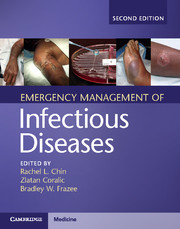Emergency Management of Infectious Diseases (2nd Ed.)
Langue : Anglais
Coordonnateurs : Chin Rachel L., Frazee Bradley W., Coralic Zlatan

This textbook is a comprehensive, evidence based, state-of-the-art resource for clinicians who diagnose and treat infectious disease.
Diagnosis and management of infectious disease are among the most common and challenging aspects of emergency practice. Ranging from surgical treatment of a minor skin abscess to recognition of a rare tropical disease in a returning traveler to rapid resuscitation of a patient in septic shock, these problems will be familiar to every practicing acute care provider. Written by both infectious disease experts and practicing emergency physicians, this book is designed specifically for the acute care provider. It covers the most important pathogens and the most common clinical syndromes, organized by system and by special patient populations. The book features a comprehensive narrative, as well as high-yield tables covering key points on diagnosis and treatment. High quality color photographs assist with visual diagnosis. This book provides an invaluable resource for every practicing clinician who confronts the spectrum of infectious disease in the acute care setting.
1. Infective endocarditis; 2. Pericarditis and myocarditis; 3. Cardiac implantable electronic device infections; 4. Altered mental status in HIV-infected patients; 5. Botulism; 6. Fever and focal cerebral dysfunction; 7. Infections affecting the spinal cord; 8. Meningitis; 9. Rabies; 10. Tetanus; 11. West Nile encephalitis virus; 12. Bacterial skin and soft-tissue infections; 13. Ectoparasites; 14. Fever and rash in adults; 15. Otitis externa;; 16. Otitis media; 17. Sinusitis; 18. Supraglottitis (Epiglottis); 19. Parotitis; 20. Pharyngitis and peritonsillar abscess; 21. Deep neck space infections; 22. Dental and odontogenic infections; 23. Infectious biliary diseases: Cholecystitis and Cholangitis; 24. Viral hepatitis; 25. Peritonitis; 26. Acute infectious diarrhea; 27. Diarrhea in HIV-infected patients; 28. Clostridium difficile infection; 29. Male genitourinary infections; 30. Nonulcerative sexually transmitted diseases; 31. Ulcerative sexually transmitted diseases; 32. Vulvovaginitis; 33. Adult septic arthritis; 34. Diabetic foot infections; 35. Hand infections: fight bite, purulent tenosynovitis, felon, and paronychia; 36. Open fractures; 37. Osteomyelitis; 38. Plantar puncture wounds; 39. Prosthetic joint infections; 40. Spine infections; 41. Conjunctival and corneal infections; 42. Periocular infections; 43. Infections of the uvea, vitreous, and retina; 44. Community-acquired pneumonia; 45. Human immunodeficiency virus-associated respiratory infections; 46. Influenza; 47. Tuberculosis; 48. Lower urinary tract infection in adults; 49. Pyelonephritis in adults; 50. Fever in the newborn; 51. The febrile child; 52. Fever and rash in the pediatric population; 53. Pediatric orthopedic infections; 54. Pediatric respiratory infections; 55. Pediatric urinary tract infection; 56. Bites (dogs, cats, rodents, lagomorphs); 57. Blood or body fluid exposure management and postexposure prophylaxis for Hepatitis B and HIV; 58. Fever in pregnancy; 59. Postpartum and post-abortion infections; 60. Fever in the returning traveller; 61. Infectious complications of injection drug use; 62. Infections in oncology patients; 63. Postoperative infections; 64. The febrile post-transplant patient; 65. Sepsis; 66. Infections in sickle cell disease; 67. Anthrax; 68. Plague; 69. Smallpox; 70. Tularemia; 71. Hantavirus; 72. Ebola virus disease; 73. Zika virus; 74. Zoonotic influenza (Novel Influenza A, including avian and swine influenza A virus infections); 75. Methicillin-resistant staphylococcus aureus (MRSA); 76. Vancomycin resistant enterococcal infections; 77. Extended spectrum beta lactamase; 78. Antimicrobial overview.
Rachel L. Chin is a Professor of Clinical Medicine at the University of California, San Francisco School of Medicine, and a doctor in the Department of Emergency Services at San Francisco General Hospital, San Francisco, California.
Bradley W. Frazee works in the Department of Emergency Medicine, Highland Hospital, Alameda Health System, Oakland, California, and is Clinical Professor of Emergency Medicine at the University of California, San Francisco.
Zlatan Coralic is an Emergency Medicine Clinical Pharmacist and Associate Clinical Professor in the Departments of Pharmacy and Emergency Medicine University of California, San Francisco.
Bradley W. Frazee works in the Department of Emergency Medicine, Highland Hospital, Alameda Health System, Oakland, California, and is Clinical Professor of Emergency Medicine at the University of California, San Francisco.
Zlatan Coralic is an Emergency Medicine Clinical Pharmacist and Associate Clinical Professor in the Departments of Pharmacy and Emergency Medicine University of California, San Francisco.
Date de parution : 08-2018
Ouvrage de 640 p.
22.3x28.3 cm
Thème d’Emergency Management of Infectious Diseases :
© 2024 LAVOISIER S.A.S.
